Frontiers To inspire and educate Salk’s Education Outreach is on a mission
A half-dozen high school students shuffle through an archway to a small microscopy room in the Salk Stem Cell Core facility.
“It’s sticky!” exclaims a tall student as they step off the clean-room mat that removed loose particles from the soles of their Converse sneakers.
Once inside the 5-by-8-foot space, the students crowd around a monitor connected to a microscope. On the screen is a black-and-white video image of … what, exactly?
A white-coated laboratory technician tells the students that they’re looking at induced pluripotent stem cells. He explains that cells taken from a person’s skin biopsy have been reprogrammed, using a custom cocktail of proteins, into these cardiomyocytes—heart-muscle cells.
Suddenly, a student in rectangular glasses blurts out, “I can see them beating!” Everyone leans in eagerly. It’s clear the cells are pulsating rhythmically. Murmurs of “Wow!” and “That’s so cool!” ripple through the group.
This is precisely the kind of wonder and excitement the Salk Institute’s March of Dimes High School Science Day was meant to inspire. The annual half-day event, which began in 1990, is one of Salk’s oldest outreach programs, with more than 5,000 students and teachers participating to date. It is named in honor of the March of Dimes, an organization that provided early research funding to Jonas Salk, long before he founded the Salk Institute. The Anne and Neal Blue High School Science Fund is a major supporter of the program.
Every year, High School Science Day introduces approximately 250 high school students from around 25 schools in San Diego County to scientists and scientific research. Of the schools, 85 percent are Title 1, which means they receive federal funds to close achievement gaps among disadvantaged students, and this year, 87 percent of attendees identified as biracial or people of color. In addition to going on lab tours like the one in the Stem Cell Core, students participate in actual laboratory activities, including DNA extraction, cell culture, pipetting, and loading electrophoresis gels, which are typically used for separating DNA in genetic studies.
High School Science Day was important to Institute founder Jonas Salk, who thought it was essential that young people be introduced to the kind of groundbreaking scientific research that led him, in the early 1950s, to develop the first safe and effective vaccine for polio, a terrifying infectious disease that can result in death or lifelong disability. Thanks to vaccination, polio has almost been eradicated globally.
Jonas Salk did not live to see additional outreach programs developed that would cement the Institute’s reputation in San Diego County as a provider of high-caliber science-education opportunities. But those who knew him—such as neurobiologist Ellen Potter, who began her Salk career in the lab of Professor Suzanne Bourgeois—are certain he would have been delighted.
“When Jonas talked to children, he looked directly at them and made them feel that there was no one more important,” Potter says. “He was really receptive to being asked questions and answering them.”
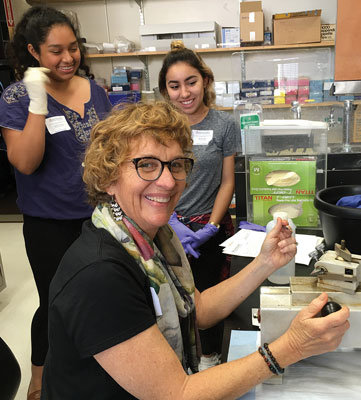
“Working side by side with teachers and science educators has been the strength of all the Salk educational programs.”
–Ellen Potter
Education Outreach
The Salk Institute’s Education Outreach program was built from the ground up by Potter, who traded her pipettes for pencils in the mid-1990s, when DNA and its applications to medicine, law, and other fields were still relatively new to the public.
Potter remembers that there were discussions among the Salk faculty about how this was an opportunity to better educate people on what DNA was all about.
Potter and a few graduate students from Salk reached out to several local school districts and were pleased when a pair of middle school teachers in the Grossmont School District expressed interest in having the scientists run a workshop on DNA technology and genetics in their respective classrooms. So, Potter and her team loaded up her van with vials of fruit flies and other supplies and headed to East County. Salk’s Mobile Science Lab was born.
Eventually, High School Science Day and the Mobile Science Lab came together under one administrative roof and became known as Education Outreach.
“Working side by side with teachers and science educators has been the strength of all the Salk educational programs,” Potter says.
Potter retired in 2016 after 38 years at the Institute, leaving as her legacy a rich tradition of inspiring and educating the next generation of students and future scientists. She was followed in the director role first by Dona Mapston and then by Monika Wert-Parkinson. Wert-Parkinson skillfully saw the staff—which includes Shoshauna Borowitz, Joshua Von Trapp, Sara Sandoval, Kate Di Carlo, and Cecilia Hill—through the pandemic, taking some programs fully online and adapting others to a hybrid model with online and in-person components.
Bryan Robinson, Salk’s vice president for External Relations, oversees Education Outreach. He says Jonas Salk’s admonition to “be good ancestors” is the motivating force of the program. “Jonas founded the Institute with the philosophy that it should both drive scientific breakthroughs and inspire the next generation of elite scientists.”
Education Outreach currently runs four programs: the Mobile Science Lab, which takes science experiments into middle schools; March of Dimes High School Science Day, a half-day of tours and activities in Salk labs; the Heithoff-Brody High School Summer Scholars Program, which offers eight-week paid internships in Salk labs; and the Edwards-Yeckel SciChats program gives elementary school students the opportunity to ask Salk scientists questions via video chat.
Salk scientists of all levels—graduate students, postdoctoral researchers, and faculty—volunteer to work alongside Education Outreach staff. The staff also offers free training and equipment to teachers, to perform biotechnology activities in their own classrooms, and holds the Ellen Potter Research Connections for Teachers Symposium annually.
According to Robinson, “Salk’s Education Outreach programs are offered for free to students, teachers, and schools, which reduces the economic barriers to a high-quality STEM education.”
The program’s mission is threefold:
- To teach students, teachers, and the community about scientific literacy in addition to the role of basic biological research in our world.
- To inspire enthusiasm and interest in advanced levels of science instruction, and particularly in science as a career.
- To promote public awareness of Salk and the value of basic research as it relates to career readiness, critical thinking skills, and the development of an informed citizenry.
Mobile Science Lab
The Mobile Science Lab visits up to 20 middle schools per year, many in underserved neighborhoods. The lab conducts three days of hands-on genetics experiments with the middle schoolers. The curriculum is the product of a collaboration between Salk scientists and San Diego educators. Day 1 focuses on phenotypes (physical characteristics) in fruit flies, the winged workhorses of genetics research. The students learn about genetic mutations and how certain mutations create observable differences in the flies.
For example, one mutation in a gene for wing shape causes normally straight wings to be curly. A mutation in a gene for eye color causes the flies’ normally red eyes to be white. (In genetics parlance, the more common, nonmutated version of the gene is called the wildtype—the type most often seen in the wild).
Salk Associate Professor Kenta Asahina works with fruit flies to understand the simple genetic and neural circuits that cause responses like aggression and escape. It’s not just about a single “aggression gene,” however—genes and neurons are just the beginning. By tracing how the molecular underpinnings of behaviors give rise to more-complicated brain activity, he aims to eventually understand social interactions in humans. Asahina is currently helping to revamp the Day 1 curriculum.
On Day 2, the students explore the question, “What color is DNA?” They learn about the differences between animal and plant cells, extract DNA from a plant cell (wheat germ), and in the process discover that DNA is clear.
On Day 3, the middle schoolers “run gels”—shorthand for performing gel electrophoresis—an important laboratory technique for sorting molecules based on their size and electrical charge. The students learn that molecules like DNA have a negative charge and will be attracted by a positive charge. They also learn that small molecules move through a gelatinous substance called agar farther and faster than large molecules. In the activity, the students drop molecules of food dye into wells at one end of a rectangle of gel, apply electric current, and watch as the dyes migrate through the gel toward the opposite end. They learn firsthand that the distance the dye molecules travel is based on their size.
More than 40,000 middle school students have now participated in Salk’s Mobile Science Lab. By doing science, students begin to see themselves as future scientists.
Well over a decade ago, one of these middle schoolers was Consuelo Sauceda. Now a graduate student working toward her PhD in biomedical sciences (BMS) at UC San Diego, Sauceda recently tweeted about the impact of the experience: “Just had the @UCSDBMS Diversity Committee session with BMS recruits and when speaking on Educational Outreach opportunities, I couldn’t help but reflect on how the Salk Mobile Science Lab helped fuel my excitement for science back when I was in middle school!”
Sauceda was born in San Diego but lived in Mexico for part of elementary school so her parents could settle her grandparents’ estates after they died. The family moved back to San Carlos shortly before Sauceda started middle school.
“None of my family is involved in science or higher education. They didn’t know what science was, or research specifically. So I was the first generation in my family to go to college, and San Marcos Middle School is where it all started for me.”
Sauceda explains that her middle school teacher, Debra Brice, “had close connections to people at Salk from previously doing research herself, so the van came out to our middle school.”
She continues, “I had people come and teach me gel electrophoresis and DNA extraction, which I thought was super cool. At the time, I think we did strawberry or kiwi DNA extractions, using the standard lab techniques that are still used today.”
The Mobile Science Lab was Sauceda’s first exposure to Salk science, but it wouldn’t be her last.
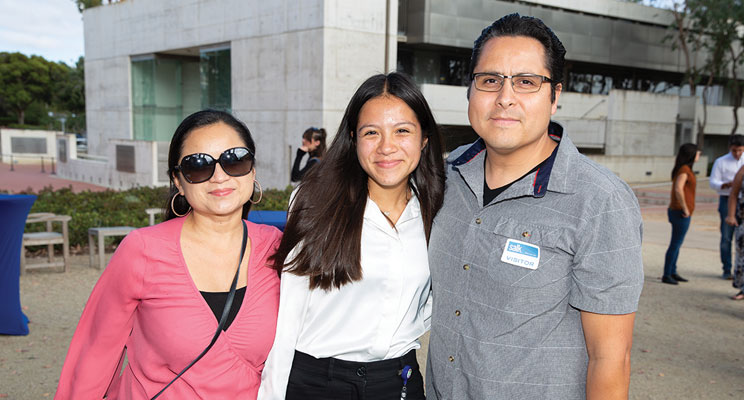
“No one in my family has a career in biology. My parents were first-generation college students, so for me to possibly be a scientist in the future is pretty awesome.”
–Isela Ordonez
March of Dimes High School Science Day
Isela Ordonez, now a junior at Orange Glen High School in Escondido, participated in High School Science Day last spring.
“It was truly amazing,” says Ordonez, for whom the timing of the event during her sophomore year was perfect.
“I always loved science classes in elementary and middle school, but it wasn’t until my freshman year biology class that I really grew an interest in it,” she explains. “Salk was my first experience [outside of school] getting exposure to what a lab looks like. I didn’t even know there were institutes specific for research.”
Ordonez’s science teacher at Orange Glen High School, Robert Shull, says that, when he had the opportunity to select two students for High School Science Day, “Isela’s name immediately came to mind. She’s the type of student who always wants to talk about science, so right away it was a no-brainer to take her.”
He remembers that Ordonez’s enthusiasm started high and remained there for the duration of the event and beyond.
“We sat down for that little intro they do in the auditorium, and one of the first things they mentioned was a summer internship opportunity. Right away, Isela turned to me and asked, ‘Do you think I could do that?’” A few hours later, when the duo met for lunch, she told him all about the lab that she had gotten to tour that morning, the research they were doing, and how she “definitely wanted to apply for the internship.”
Heithoff-Brody Summer Scholars Program
The High School Summer Scholars program is an eight-week, paid internship during which students conduct full-time research projects in a Salk lab. They formulate and test hypotheses, prepare experiments, participate in group meetings, and tour neighboring research facilities. After a rigorous application process, only 12 students out of 400 applicants are accepted each year; the unusual chance to do actual research alongside world-class scientists makes it a coveted opportunity. The students’ summer salaries are funded in part by the San Diego Foundation.
“We’ve had a wide range of students,” Potter says. “Some were very well qualified and had parents that encouraged them, and then there have been others that didn’t have anyone who was even remotely aware of what biomedical research was. The strength of the program is that we’ve been very, very attuned to making sure the student and mentor are well matched. And we’ve had funding for the summer salaries, which allows students that need to work during the summer to still participate.”
Potter credits longtime colleague Dona Mapston for ensuring that the Summer Scholars program reached its full potential, and for the expansion of the Mobile Lab to serve all of San Diego County. Mapston was a high school AP science teacher before joining Education Outreach and was Potter’s professional partner for 15 years.
“It was Dona’s commitment to excellence that led to the high educational standards for all of the Education Outreach programs,” Potter says.
Last spring, when the summer internship application opened a few weeks after High School Science Day, Shull helped Ordonez prepare her application, wrote her a letter of recommendation, and conducted mock interviews with her for practice. She applied, then they waited anxiously to hear back.
“I’ll never forget it—it was during my sixth period class, and she ran into my classroom almost screaming, ‘I got the internship!’ It’s one of the highlights of my career,” says Shull.
When Ordonez talks about her eight weeks as a Summer Scholar this past summer, you can hear her justified pride in her accomplishments. “I had my own research project, which is super empowering to me. I, myself, contributed to research and got experience in a lab with real scientists. I had a huge support system, with four mentors, as well as [the Education Outreach team] and the other interns I was with. Not only did I do research, but I presented my research, too. I also had the opportunity to visit different biotech companies and talk to people with different careers within science.”
Ordonez’s family came to see her presentation about her research on the maize genome. “They’re super proud of me,” she says. “No one in my family has a career in biology. My parents were first-generation college students, so for me to possibly be a scientist in the future is pretty awesome.”
Shull echoes how transformative Ordonez’s Salk experiences have been. “One of my favorite things is just seeing Isela’s confidence since this internship. She’s been coming in during my prep period to read scientific articles together. The coolest part is she’s spreading [her enthusiasm] to other kids. She’s inviting other kids to come read articles with us. It’s the ultimate moment as a teacher.”
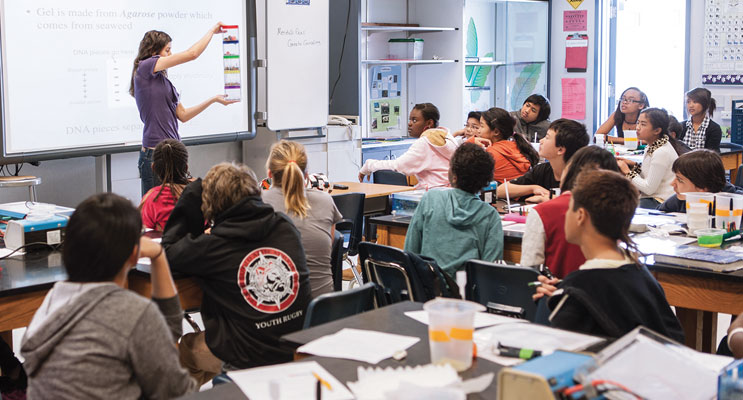
“We’ve been very impactful in San Diego County and we’re very proud of that. But our goals for the future are really to be able to figure out ways to partner with national organizations and scale up to a national level and broaden our impact.”
–Bryan Robinson, Salk VP for External Relations
Beyond High School
Consuelo Sauceda, who experienced Salk’s Mobile Science lab during middle school, also participated in High School Science Day.
“I went on to tour the Salk Institute officially for the first time with my high school chemistry teacher,” Sauceda explains. “And we got to see pictures and learn about glow-in-the-dark mice. That was my first ever true exposure to real science. I remember getting to talk to scientists—like actually be in the lab, be exposed to all the things that they do. I thought it was so amazing and I just knew that was something I wanted to do someday. I felt research was an avenue I could explore in hopes of having an impact on human health, especially after learning of the origin story behind the Salk and its founder, Jonas Salk.”
Sauceda went on to college at CSU San Marcos, where she majored in biochemistry, conducting research with a marine bacterium called Mycobacterium marinum and trying to find new antibiotics to treat tuberculosis.
After college, Sauceda worked as a lab technician at UC San Diego. She then applied to graduate school there and is now working toward her doctorate in David J. Gonzalez’s lab, studying host-microbiome interactions. Specifically, she is trying to identify and quantify microbial proteins to understand how different diets may change the composition of the gut microbiome in conditions such as inflammatory bowel disease.
Now in her fourth year of graduate school, Sauceda tears up when talking about how proud her parents have been of what she’s accomplished. “I’ve been fortunate enough to go down this path without really having much guidance. But the people I’ve met, the mentors that I’ve had along the way, and the educational outreach like this is so integral for people like me, because we otherwise wouldn’t have had the opportunity or exposure. My mom knew this would be something that was good for me. She didn’t understand it herself, but she tried her hardest to help me get to the point where I am today.”
Sauceda’s mother passed away two years ago, but Sauceda is looking forward to having her father and friends watch her defend her thesis in the near future.
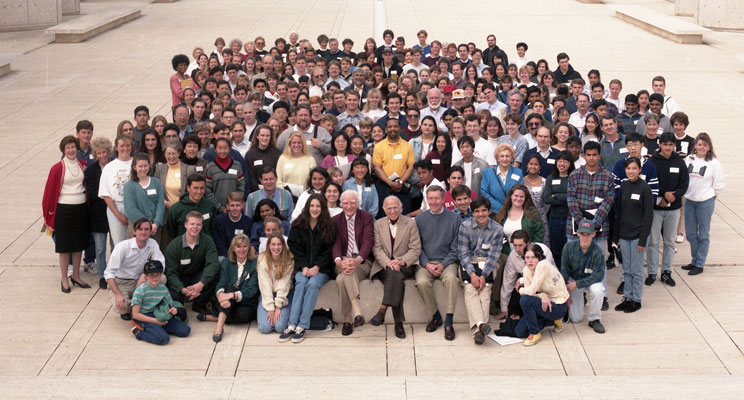
“I see every human being as having a purpose, a destiny, if you like—the destiny that exists in each of us—and [we must] find ways and means to provide such opportunities
for everyone.”–Jonas Salk
Expanding Outreach
Ellen Potter is confident that Jonas Salk would also have been proud of Sauceda, Ordonez, and the thousands of other students who have been inspired either to pursue careers in science or to support science, thanks to Salk’s Education Outreach programs.
“I know that Jonas would be very thrilled with what Education Outreach has achieved because he felt that science couldn’t be an ivory tower,” Potter says. “We have to be—you know his phrase—good ancestors. And part of being a good ancestor is inspiring young people.”
Robinson adds, “We’ve been very impactful in San Diego County and we’re very proud of that. But our goals for the future are really to be able to figure out ways to partner with national organizations and scale up to a national level and broaden our impact.”
The Education Outreach staff have lots of plans for 2024. For example, the team will pilot a four-day workshop focused on Salk’s Harnessing Plants Initiative to store excess carbon from the atmosphere deep within the roots of crop plants.
“The Institute is very committed to Education Outreach, but it does rely upon philanthropic support to grow,” says Robinson. “Corporations, foundations, and individuals who care about scientific literacy all have an important role to play in helping create a diverse workforce for the future.”
As Jonas Salk said, “I see every human being as having a purpose, a destiny, if you like—the destiny that exists in each of us—and [we must] find ways and means to provide such opportunities for everyone.”
Demystifying and diversifying the path to becoming an academic scientist
This defines the educational path to becoming an academic scientist—a faculty member at a place like the Salk Institute. At each stage, the Salk Institute’s Education Outreach team and Office of Diversity, Equity & Inclusion provide opportunities for thousands of students, a majority of whom come from underrepresented and underserved communities, to take part in innovative learning experiences and explore careers in science. These programs are offered at no cost, thereby reducing economic barriers to high-quality science education—and ultimately helping to diversify the scientific career pipeline
1. Middle school student
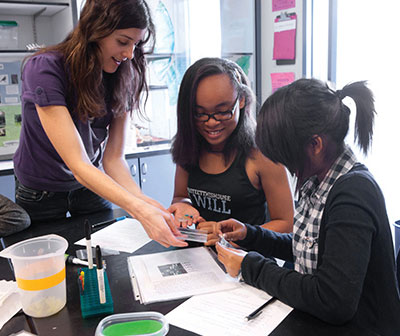
The Salk Mobile Science Lab team travels to middle schools throughout San Diego County, bringing a free, three-day program that includes studying fruit flies under a microscope, isolating plant DNA, and learning about DNA analysis techniques. The Teacher Activity Kit program provides free training and supplies for middle and high school teachers interested in bringing hands-on activities into their classrooms. Kits include all necessary supplies and lesson plans.
2. High school student

Each year, Salk hosts March of Dimes High School Science Day, opening our doors to hundreds of students and their teachers for a day that features Salk scientists sharing stories of their work life, lab tours, and the opportunity to participate in scientific experiments.During the annual eight-week, paid Heithoff-Brody Scholars Program, high school student interns work in Salk labs, as well as spend time in seminars, workshops, data analysis projects, and other enrichment activities. At the end of the program, students present their research projects to their mentors, lab peers, and families.Launching in January 2024, Salk’s Harnessing Plants Initiative four-day workshops will be piloted in five high school classrooms across San Diego County. These workshops teach critical laboratory skills, experiment design, data analysis, and scientific communication.At the Ellen Potter Research Connections for Teachers Symposium, middle and high school teachers hear from Salk scientists in a seminar environment, then collaborate with colleagues to apply what they have learned to create lesson plans applicable to their classrooms.
SciChats@Salk is a free virtual interactive experience that pairs a classroom with a volunteer researcher for an interactive conversation about what it’s like to be a scientist.
3. College student

The Salk Summer Undergraduate Research Fellowship (SURF) is a 10-week, paid internship that provides college students with research experience, access to world-class research facilities, and a network of mentors. This program is open to students with limited or no research experience.
4. Graduate student working toward a PhD
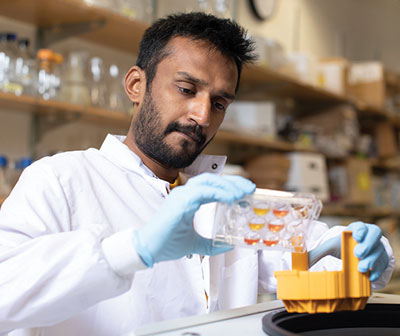
The Salk EDGE Summer Program is a two-week summer program that aims to Elevate Diversity in Graduate Education by equipping graduate students for competitive careers in academic science. Students are trained on cutting-edge techniques, and the program also supports the use of these new techniques in their home labs through a $2,000 pilot grant to be used in their PhD labs.
5. Postdoctoral trainee
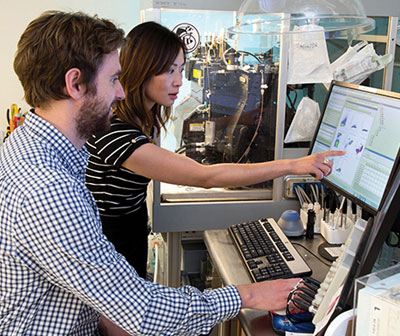
At the annual Salk Rising Stars Symposium, select postdoctoral trainees—scientists who have completed their PhDs but do not yet run their own research programs—present their research at Salk, are provided with networking opportunities, and are paired with a Salk faculty member for mentorship. Rising Stars postdoctoral trainees are also kept informed about upcoming faculty recruitment opportunities.
6. Junior faculty member (principal investigator)
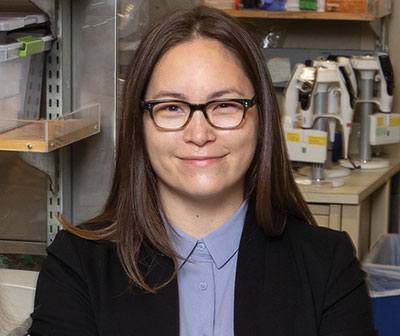
Faculty members—from assistant to associate to full professor—are scientists who lead their own research teams made up of approximately five to 30 staff scientists, postdoctoral trainees, and graduate and undergraduate students. They set the research directions for their labs, develop new research questions to pursue, guide experiments, and hire and mentor their lab members. They apply for grant funding, publish papers, file patents, present their lab’s work at conferences, collaborate with other labs, and sometimes found spin-out companies. To encourage their success, junior faculty members at Salk are provided with networking and funding opportunities, grant writing assistance, and mentorship from senior faculty. At Salk, faculty members also have internal funding opportunities and are nominated for awards.
Support a legacy where cures begin.
Featured Stories
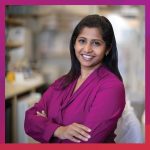 Deepshika Ramanan–From iguana poop to breastmilkRamanan, a new assistant professor and microbiologist by training, made a chance discovery about animal gut bacteria that led to her fascination with breastmilk immunity.
Deepshika Ramanan–From iguana poop to breastmilkRamanan, a new assistant professor and microbiologist by training, made a chance discovery about animal gut bacteria that led to her fascination with breastmilk immunity. New strategic plan provides roadmap for enhancing diversity, equity, inclusion, and belonging at SalkGroundbreaking scientific discoveries require talented people behind the scenes, and the more diverse those people are, the more groundbreaking their discoveries. At Salk, improving diversity, equity, and inclusion is a commitment to both scientific discovery and humanity.
New strategic plan provides roadmap for enhancing diversity, equity, inclusion, and belonging at SalkGroundbreaking scientific discoveries require talented people behind the scenes, and the more diverse those people are, the more groundbreaking their discoveries. At Salk, improving diversity, equity, and inclusion is a commitment to both scientific discovery and humanity.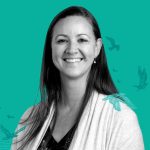 Trinka Adamson–Supporting Salk science through animal careAdamson, senior director of Salk’s Animal Resources Department, works to provide the highest quality veterinary medical care, husbandry, enrichment, and professional technical support to enable our scientists to conduct their animal research and make their bold discoveries.
Trinka Adamson–Supporting Salk science through animal careAdamson, senior director of Salk’s Animal Resources Department, works to provide the highest quality veterinary medical care, husbandry, enrichment, and professional technical support to enable our scientists to conduct their animal research and make their bold discoveries.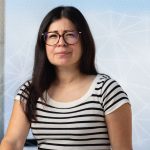 Melissa Hernandez–Horses, hot sauce, and human brain researchHernandez, a postdoctoral researcher in the lab of Professor Rusty Gage, journeyed up and down the west coast and turned from scientist to hot sauce entrepreneur and back before finally settling at Salk to study neuroscience.
Melissa Hernandez–Horses, hot sauce, and human brain researchHernandez, a postdoctoral researcher in the lab of Professor Rusty Gage, journeyed up and down the west coast and turned from scientist to hot sauce entrepreneur and back before finally settling at Salk to study neuroscience. To inspire and educate: Salk’s Education Outreach is on a missionMotivated by Jonas Salk’s admonition to “be good ancestors,” Education Outreach strives to inspire the next generation of scientists. By running programs like the Mobile Science Lab or High School Science Day among others, Education Outreach encourages scientific literacy, enthusiasm in science as a career, and awareness of the value of basic research.
To inspire and educate: Salk’s Education Outreach is on a missionMotivated by Jonas Salk’s admonition to “be good ancestors,” Education Outreach strives to inspire the next generation of scientists. By running programs like the Mobile Science Lab or High School Science Day among others, Education Outreach encourages scientific literacy, enthusiasm in science as a career, and awareness of the value of basic research.




















































